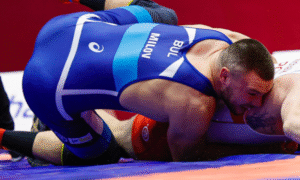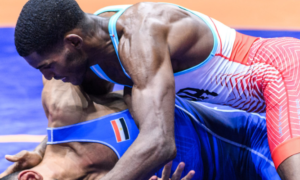“I would say if you don’t tell him, then it’s fine.” That’s Lucas Steldt, the head coach of the Combat Wrestling Club. He’s talking about whether or not it’s difficult to teach the finer points of Greco Roman wrestling to the typical folkstyle athlete. Years and years of being brought up in the scholastic system can make the international styles, particularly Greco Roman, appear somewhat intimidating to the uninitiated. So Steldt goes with a different approach: Present Greco techniques inside of folkstyle training so the wrestlers learn without realizing it.
“What I do is if we are training folkstyle, we are training Greco at the same time,” Steldt says. “Two-on-ones and underhooks are Greco.” With this approach also comes a reputation. “We are known for throwing guys. Parents don’t want it taught. Coaches don’t want it taught, and athletes don’t want it taught because they’re scared.” He would know. Once a high school head coach, Steldt now has his finger firmly resting on the pulse of US Greco Roman wrestling. Combat Wrestling Club, located in Blue River, Wisconsin, is one of few wrestling academies across the country which features Greco as a primary discipline of study. Normally, Greco and freestyle are throw-ins at your local club during the spring and summer months. Not at Combat. That is because Steldt is driving at something different. His vision is to help Greco-Roman supersede the more traditional folkstyle as the preeminent focus for US wrestlers moving forward.
“Our mission is to get kids to strictly wrestle Greco and bypass high school wrestling,” proclaims Steldt. “I’d be lying if I said I wanted them to wrestle in high school and college. Even though I know kids do that stuff, we train Greco Roman 100%.” If mixing Greco in during the folkstyle season already seems like evidence Steldt knows there is a bit of an uphill battle in front of him, you’re not far off. Many Greco coaches lament the time missed in the style that was instead expended in folk. But folkstyle is overwhelmingly the first style Americans learn and that means undoing an awful lot of programming once wrestlers become acquainted with Greco, whenever that happens.
In order to contend with this dilemma, Steldt not only introduces Greco-Roman to any and all athletes during the winter months, but he also pays specific attention to the technical disparity so that there is a baseline with which to work. That’s where the process really begins at Combat. “It is so hard to get them from being a really good wrestler to a World Team-caliber wrestler because they’ve been taught morbidly different techniques,” continues Steldt. “They can’t get over the hump because their bodies have been trained in the folkstyle neural pathways.” Such is the mission if you’re a Greco-Roman coach in the United States, should you choose to accept it. At Combat, this mission is a fabric of everyday life.
Naturally, the first question to be asked is, What got Combat started in the first place? Surely, most inside the wrestling community know that Wisconsin has perennially been recognized as one of the strongest Greco areas in the country. Even this year, two athletes from the Badger State are on the US Greco Roman Olympic Team – Ben Provisor (85 kg) and Jesse Thielke (59 kg). But notoriety doesn’t necessarily translate into numbers. Wisconsin legend Dennis Hall has his own successful World Gold Wrestling operation but other than that, the pickings are surprisingly slim when it comes to new wrestlers gaining serious experience in the discipline. Combat represents a different opportunity in that regard.
In just over a decade, Combat WC has become a premier destination for would-be Greco athletes and (wait for it) serious high school wrestlers alike. But because the program is on a short list of academies that include a legitimate Greco curriculum, people are willing to log more than a few miles to get in on the action. “I have something going on in Blue River,” Steldt says. “People are driving more than four hours to come by.” That should say it all right there — but it’s only the beginning. The attraction athletes have to Combat goes part and parcel with the program itself as well as some of the athletes who call the facility home. Between a growing number of Fargo Nationals place winners and Wisconsin high school state champions, success has become the norm. But it doesn’t happen in a vacuum. A lot of hard work along with a focused, studious approach to everything from developmental basics to positional minutiae represent the keys to Combat’s principles.

A typical practice session at Combat looks like something like this: A game kicks off the warming-up process (usually handball). After that, it’s gymnastic movements and motions for 10 to 15 minutes. Dummy throws are next (“Every day we throw dummies,” says Steldt). There is also a point of emphasis each practice and it can differ depending on what the athletes need. Steldt shares that currently there is an emphasis on underhooks (“Initial contact, how to move the guy and all of the nuances of that process in a show-and-tell style”). Some sparring, drilling, par terre defense, and full live wrestling round out the body of the program. And then at the end of each session, the wrestlers return to the first item of the day they learned to hone in on it even more (“They learn to do it fresh, sweaty, and tired”). But a certain code of ethics is involved, as well. “It’s more like, ‘Hey, make sure you stay humble, listen to your mom and dad, and do good in school.’ Just positivity to keep them on task,” Steldt assures.
Getting back to the divide that exists in the United States at least on a peripheral level, many have wondered if Greco-Roman wrestling is translatable to athletes of any style. The debate centers around whether you can take a wrestler, any wrestler, and make him adaptable to Greco. Some would say that, Sure, wrestling is wrestling. But Steldt isn’t convinced. To him, there is a certain mold one has to come from in order to take to it. “I have guys who want to attack legs. Guys who are freestyle are freestyle, and Greco guys are Greco guys.” The two styles of wrestling do share some similarities, although Greco, where leg attacks are forbidden, is based on constant pressure and contact. Bumps and bruises are as common as laces in a pair of shoes. Steldt expounds on this point. “You can’t teach a guy to be physical. Technique can come later. You know, he’s got to like rolling around in the dirt on the playground. He’s got to be fearless.”
One thing that benefits the athletes of today is the sheer number of resources available to them. If someone wants to learn how to become a Greco specialist, then the only thing holding them back is that there aren’t enough places like Combat. But they can witness plenty of action in places like YouTube and FLO Wrestling should they feel the desire to dive head-first into the world of Greco-Roman. Steldt wasn’t as lucky. Like most, he started out on the folkstyle path and discovered only later on that Greco was where he was supposed to be. That meant he had to lock onto information any way he could.
“In college is when I got into Greco. I had some friends who were very into it. I wanted to see what it was.” Steldt recognized something in the sport he couldn’t turn away from. “I always wanted to be grabbing guys and be physical. But I wanted to know how to do it correctly. The unseen things really attracted me. I was always reading and getting video, and by the time you got to watch matches, they were three-years-old because of no internet. There was no education on it. I became a student of the sport. I learned it, I taught it, I learned it, I taught it. And that’s what I still do today.” The thing is, Steldt is being modest. As Combat has grown since its inception in 2004, so has Steldt’s presence. He has been a coach for the state of Wisconsin on both the Cadet and Junior levels, and has also been invited to the Olympic Training Center as a guest instructor along with accompanying national teams overseas. In other words, his has become a voice people listen to when it comes to concentrated Greco technique.
The path has been set. Greco Roman wrestling is growing in America in ways once thought unfathomable. The former high school wrestling coach who rediscovered his life’s passion has become entrenched as a name people look to, so it’s only reasonable his perspective should fit the current tone. Combat WC is emerging right along with the sport and Stedlt enjoys a front-row seat to witness it all taking place. “I stayed the course and stayed positive and I’m proud of where we started and where we are going,” Steldt discloses proudly. “I can feel the snowball effect coming. I say ‘we’ because it’s not just me. It’s parents who pay fees, do fundraisers, build things, help out.” It might be a team effort, but he’s the leader. And people are following. That isn’t a coincidence, not when the goals are lofty but reachable.
“I think we are close to breaking through. We need guys on the World Teams and Olympic Teams. That’s our goal and we are on our way.”


















